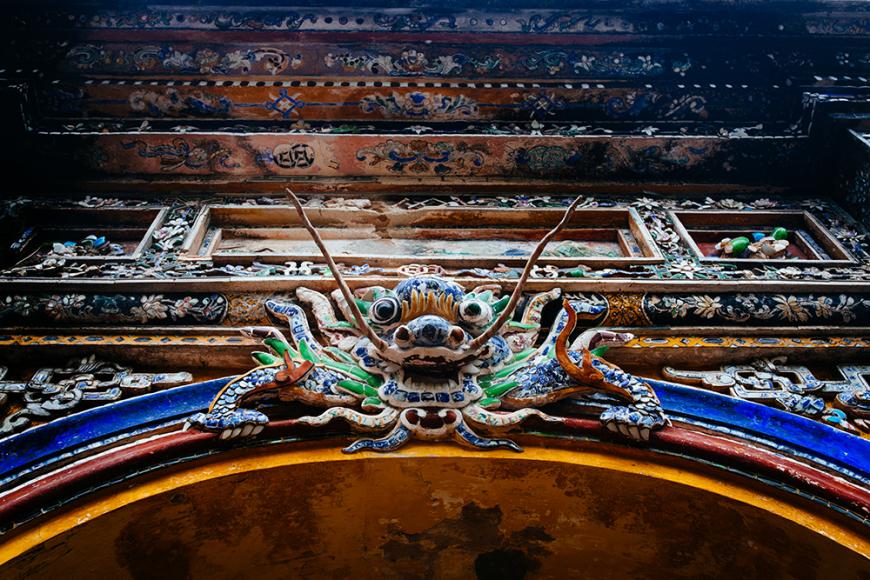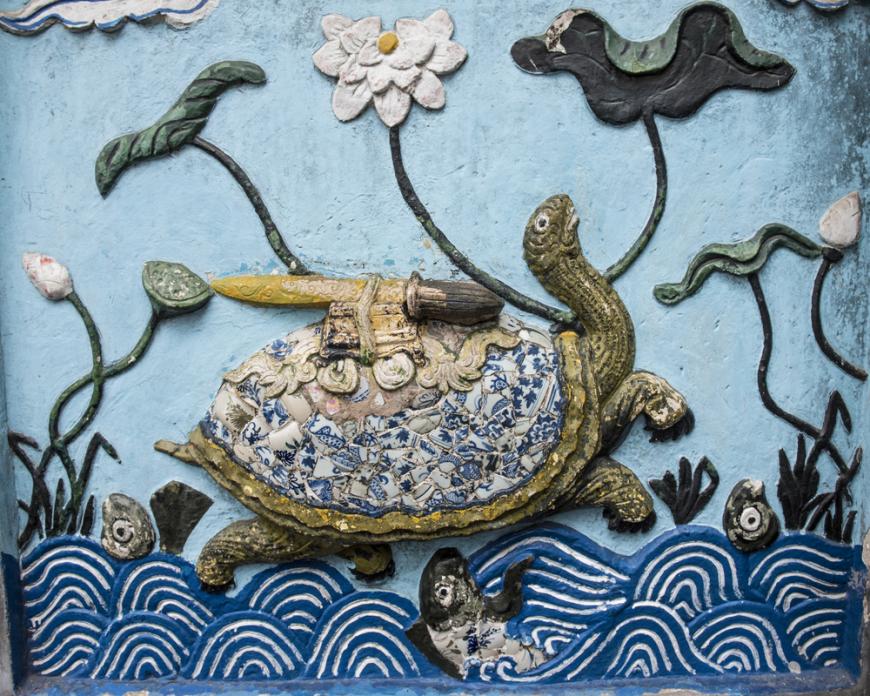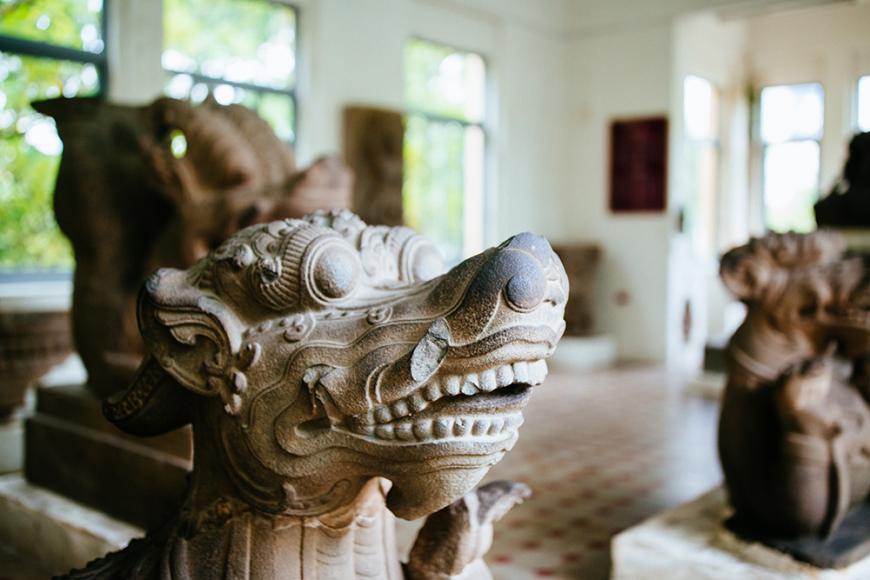The four sacred animals of Vietnam
When you visit ancient pagodas and palaces in Vietnam, you’ll see many depictions of mythical creatures. Here, we present the most influential ones - the Four Sacred Animals: Dragon, Kỳ lân, Tortoise and Phoenix.
Water Dragons
According to the nation’s founding myth, Vietnamese people are the offspring of a sea dragon and a mountain fairy. As such, dragons have a special place in the nation’s psyche. Unlike the dragons depicted in the West, Vietnamese dragons have lithe, sinuous bodies. They rise out of water and bestow good luck—and rain—upon humanity.
To understand the importance of dragons in Vietnamese culture, take a look at the names of locations. Having freed the nation colonial rule in 1010, King Lý Thái Tổ is said to have seen a dragon take flight on the banks of the Red River. He chose this spot as the site of his capital, which he christened “Thăng Long”—Rising Dragon. The site has now been renamed as Hanoi. Meanwhile, Hạ Long Bay, which translates to The Bay of the Descending Dragon, gets its name a legend about a dragon that dove into the sea and churned up less islands with its thrashing tail.
In the 15th century, when Confucianism reached its peak in Vietnam, the dragon became a symbol of feudal power. The dynasty issued strict rules governing dragon images—only kings could use five-clawed dragon motifs. In Hanoi’s Thăng Long Citadel, the stone dragon staircase of Kính Thiên Palace is a wonderful example of a 15th century dragon design. In Huế, the Palace of Supreme Harmony, built in 1805, features columns, roof ridges and eaves decorated with golden Nguyễn Dynasty dragons. Dragon motifs continue to evolve and remain relevant today—as shown by Đà Nẵng’s popular Dragon Bridge, which opened in 2013 and emits bursts of fire and jets of water at 9pm on Saturday and Sunday nights.

Water dragons guarding the archway. Photo by Aaron Joel Santos.
Kỳ lân Unicorns
Sometimes translated as a “unicorn”, the Kỳ lân is a weird mishmash of creatures. Some researchers claim it blends elements of a horse, buffalo and dragon. Others describe it as a “lion-horse”. And others insist it has the feet and horns of a deer, the eyes of an eagle, the nose of a lion, the mouth of a crocodile and the body of a horse… Everyone agrees that Kỳ lân are loyal, peaceful and merciful, which is why they guard temples, pagodas and palaces.
Adapted China, Kỳ lân motifs appeared in Vietnam during the later Le Dynasty (1428-1789). Their popularity soared during the Nguyễn Dynasty. Carved wooden Kỳ lân often decorated screens and bell stands, as their roars were said to resemble ringing bells.
In the former Royal Citadel in Huế, two bronze Kỳ lân statues stand in the corners of the great court in front of the Palace of Supreme Harmony. These statues served to remind court mandarins to be on their best behaviour. One of the best ways to appreciate the ongoing relevance of these magical beasts is during the Lunar New Year and Mid-Autumn Festivals, when unicorn dance troupes take to the streets. Accompanied by wild drumming, these dances capture the imposing yet playful spirit of the Kỳ lân.
Horse, buffalo or dragon? The ky lan "unicorn" is actually a hybrid. Photo by Justin Mott.
Wise Tortoises
A symbol of strength and longevity, the Tortoise has long been the subject of legend in Vietnam. A Tortoise God is said to have helped King An Dương Vương build the Cổ Loa Citadel near Hanoi in the third century BC. Another legend claims King Lê Lợi defeated foreign invaders after a magical Tortoise (or turtle) rose Hanoi’s Hoàn Kiếm Lake and gave him an enchanted golden sword. Generations of Hanoians kept an eye out for the giant turtles that lived in Hoàn Kiếm, as sightings were considered lucky. Sadly, one ancient Hoàn Kiếm turtle died in January 2016, weighing more than 170kg. The little temple in the centre of the lake is called Tháp Rùa—the Tortoise Tower.
In sacred places, the Tortoise is often depicted with a Crane standing on its back. Since the Tortoise is said to live for 10,000 years and the Crane for 1,000, this image is shorthand for: “May you be remembered for 1,000 years and honoured for 10,000”. The nation’s most famous Tortoise images are found in Hanoi’s Temple of Literature, built in 1070. Here, 82 stone Tortoises carry steles commemorating the nation’s best scholars.

The mystical tortoise is part of Hanoi's creation story. Photo courtesy of Shutterstock.
Noble Phoenixes
Last but not least is the Phoenix, associated with nobility and beauty. Some researchers believe the Lac bird found on Đông Sơn bronze drums is an early form of the Phoenix. In Vietnam, Phoenixes came in pairs - the female “Phượng” and the male “Hoàng”, typically shown facing each other. Later, the Phoenix came to be teamed with the Dragon to represent love and prosperity.
During the Lý and Trần dynasties, Phoenix designs often graced palace roofs. Look for the intricate giant ceramic Phoenix heads on display in the Imperial Citadel of Thăng Long, which was once called the Phượng (Phoenix) Citadel. During the Lê dynasty (1428-1789), Phoenixes came to be associated with queens and royal women, whose robes were decorated with these magical birds. During the Nguyễn dynasty, Phoenix images designated a noblewoman’s status. The empress’ crown and robes bore nine golden Phoenixes.
In the former imperial city of Huế, Phoenix images adorn palace roofs, walls and gates. Also in Huế, the 2000-kg bell in Thiên Mụ Pagoda, forged in 1710, is engraved with stunning Phoenix and Dragon imagery. Being associated with luxury and femininity, Phoenix embroidery motifs remain popular on Vietnam’s traditional áo dài tunics.

Posts same category
- CNN to beam Vietnam’s cultural heritages to global audiences(03/07)
- Hawkers on bicycles peddle fragrance on the go(25/06)
- Vietnam emerges top Asia-Pacific travel choice for Russians(18/06)
- Red blossoms light up northern Vietnam city(18/06)
- Saigon specialty market caters to pest killing festival(18/06)










 Share:
Share:









